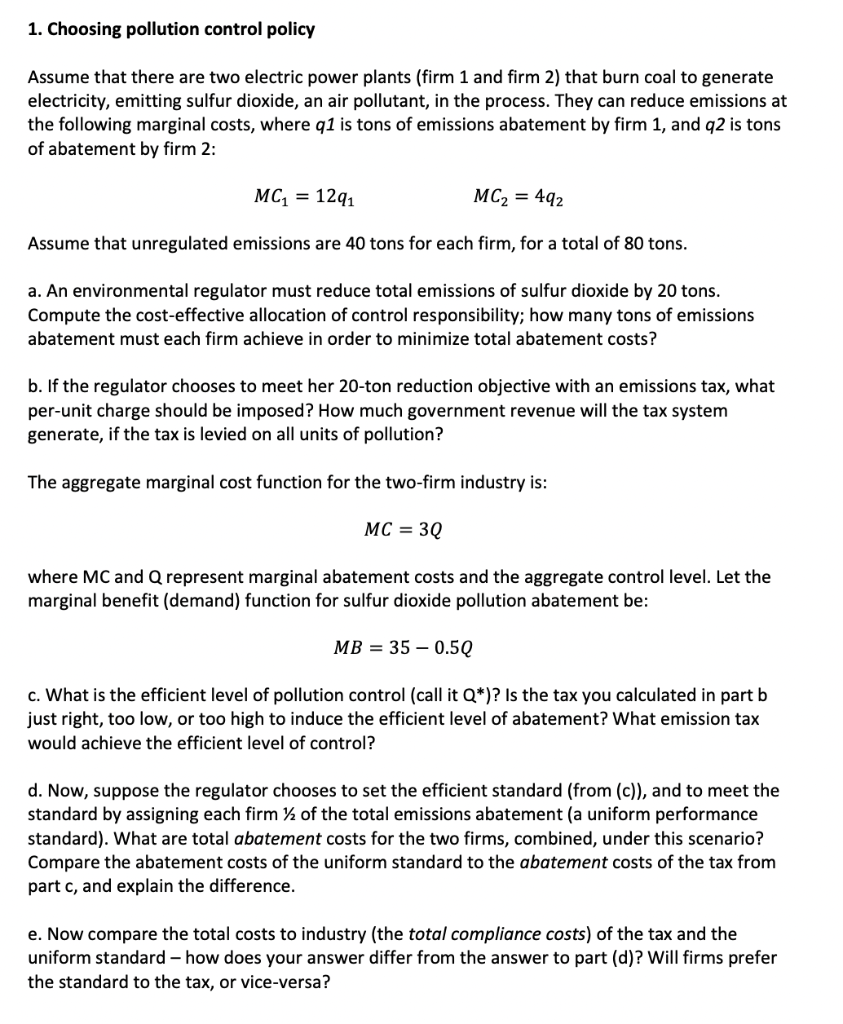
1. Choosing pollution control policy Assume that there are two electric power plants (firm 1 and firm 2) that burn coal to generate electricity, emitting sulfur dioxide, an air pollutant, in the process. They can reduce emissions at the following marginal costs, where q1 is tons of emissions abatement by firm 1 , and q2 is tons of abatement by firm 2 : MC1=12q1MC2=4q2 Assume that unregulated emissions are 40 tons for each firm, for a total of 80 tons. a. An environmental regulator must reduce total emissions of sulfur dioxide by 20 tons. Compute the cost-effective allocation of control responsibility; how many tons of emissions abatement must each firm achieve in order to minimize total abatement costs? b. If the regulator chooses to meet her 20-ton reduction objective with an emissions tax, what per-unit charge should be imposed? How much government revenue will the tax system generate, if the tax is levied on all units of pollution? The aggregate marginal cost function for the two-firm industry is: MC=3Q where MC and Q represent marginal abatement costs and the aggregate control level. Let the marginal benefit (demand) function for sulfur dioxide pollution abatement be: MB=350.5Q c. What is the efficient level of pollution control (call it Q )? Is the tax you calculated in part b just right, too low, or too high to induce the efficient level of abatement? What emission tax would achieve the efficient level of control? d. Now, suppose the regulator chooses to set the efficient standard (from (c)), and to meet the standard by assigning each firm 1/2 of the total emissions abatement (a uniform performance standard). What are total abatement costs for the two firms, combined, under this scenario? Compare the abatement costs of the uniform standard to the abatement costs of the tax from part c, and explain the difference. e. Now compare the total costs to industry (the total compliance costs) of the tax and the uniform standard - how does your answer differ from the answer to part (d)? Will firms prefer the standard to the tax, or vice-versa? 1. Choosing pollution control policy Assume that there are two electric power plants (firm 1 and firm 2) that burn coal to generate electricity, emitting sulfur dioxide, an air pollutant, in the process. They can reduce emissions at the following marginal costs, where q1 is tons of emissions abatement by firm 1 , and q2 is tons of abatement by firm 2 : MC1=12q1MC2=4q2 Assume that unregulated emissions are 40 tons for each firm, for a total of 80 tons. a. An environmental regulator must reduce total emissions of sulfur dioxide by 20 tons. Compute the cost-effective allocation of control responsibility; how many tons of emissions abatement must each firm achieve in order to minimize total abatement costs? b. If the regulator chooses to meet her 20-ton reduction objective with an emissions tax, what per-unit charge should be imposed? How much government revenue will the tax system generate, if the tax is levied on all units of pollution? The aggregate marginal cost function for the two-firm industry is: MC=3Q where MC and Q represent marginal abatement costs and the aggregate control level. Let the marginal benefit (demand) function for sulfur dioxide pollution abatement be: MB=350.5Q c. What is the efficient level of pollution control (call it Q )? Is the tax you calculated in part b just right, too low, or too high to induce the efficient level of abatement? What emission tax would achieve the efficient level of control? d. Now, suppose the regulator chooses to set the efficient standard (from (c)), and to meet the standard by assigning each firm 1/2 of the total emissions abatement (a uniform performance standard). What are total abatement costs for the two firms, combined, under this scenario? Compare the abatement costs of the uniform standard to the abatement costs of the tax from part c, and explain the difference. e. Now compare the total costs to industry (the total compliance costs) of the tax and the uniform standard - how does your answer differ from the answer to part (d)? Will firms prefer the standard to the tax, or vice-versa







